 {Macallen Way: Overhead Detail (Photo: John Horner Photography)}
{Macallen Way: Overhead Detail (Photo: John Horner Photography)}
ASLA just announced their 2009 awards. After perusing the selections I picked out a couple I felt had understated qualities.
 {Macallen Way: Overhead Detail (Photo: John Horner Photography)}
{Macallen Way: Overhead Detail (Photo: John Horner Photography)}
ASLA just announced their 2009 awards. After perusing the selections I picked out a couple I felt had understated qualities.
 {An augmented reality architectural form, driven by real time environmental information such as temperature, brightness, humidity, wind direction and sound. nodes reflecting the sensor network are the seeds for the virtual architecture, growing and subsiding like an organism. Image via Information Aesthetics}
{An augmented reality architectural form, driven by real time environmental information such as temperature, brightness, humidity, wind direction and sound. nodes reflecting the sensor network are the seeds for the virtual architecture, growing and subsiding like an organism. Image via Information Aesthetics}
As technology advances our ability to extract and display information beyond simple pie charts and graphs present new possibilities for understanding our physical environments. We recently discussed in our CityScene post how these new informational graphics are able to communicate the vast complexities that make up our cities, which more effectively equip landscape architects for proper design.
The immediacy of social media networks like Twitter, as with the recent swine flu case, has shown how quickly information can be disseminated to the masses. So why can't we as landscape architects adapt this ability to communicate the status of urban spaces and environments?
An article from SEED has us thinking that this is clearly possible. “How would it change your ideas about moving around in the world, if you could suddenly sense things you couldn’t see?” asks Eric Paulos, an assistant professor at Carnegie Mellon’s Human-Computer Interaction Institute. Paulos wants to put tiny environmental sensors in cell phones and turn phone users into roving citizen scientists who continuously sample and respond to their personal environment. This type of local and real-time environmental data would not only facilitate science and satisfy individual curiosity, it will empower people to uncover, visualize, and collectively share information about their own neighborhoods and cities. It could ultimately encourage active participation in protecting and improving those spaces.
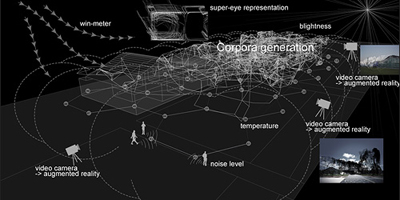 {Image via Information Aesthetics}
{Image via Information Aesthetics}
Armed with this new environment gauging technology, spatial and environmental data could be sent to city planning office hubs, which a program monitors and automatically records and displays the readings via data visualization tools. Geo-spatial mapping taken from camera phones, cell phone usage monitoring will reveal real-time urban space usage and tell the effectiveness of these areas. Certain cell phone technologies that are able to detect moods from visitors once recorded will also enable psychology of space mapping.
These technologies will also monitor urban micro climates, and any pollution effecting these areas, which will allow officials to immediately act to resolve any issues.
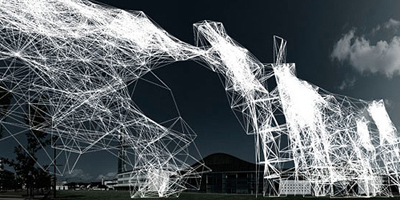 {Image via Information Aesthetics}
{Image via Information Aesthetics}
This has vast implications for landscape architects. Much of our work is commissioned after long and laborious case studies show that a certain space has been improperly designed or simply no longer relevant due to an evolving cityscape. By this time, complete and costly renovations have to be made, but long after these spaces have laid in a state of social and environmental disrepair.
With advanced interactive environment gauging mobile technologies, landscape architects can be quickly and more abundantly engaged in design solutions. They'll immediately be provided with the recorded mappings and data visualization graphics which they will use to resolve urban design and environmental inefficiencies.
During this time of severe economic slowdown, we as landscape architects need to embrace a paradigm shift of how we approach the profession and become a part of the design and development of advanced social/environment measuring media, not only will it better equip us to properly do our jobs, but it will provide vast amounts of work for our profession.
Let's get a dialogue going of the possibilities.
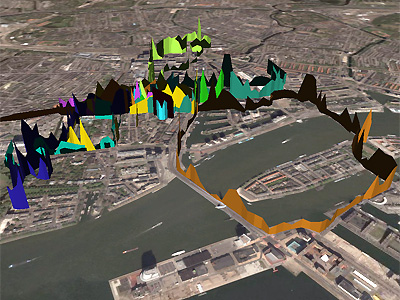 {In this visulisation the height of each track point indicates that individuals physiological arousal at that geographic location. Image via BioMapping}
{In this visulisation the height of each track point indicates that individuals physiological arousal at that geographic location. Image via BioMapping} {Detail of Greenwich Emotion Map. Image via BioMapping}+ Information Aesthetics
{Detail of Greenwich Emotion Map. Image via BioMapping}+ Information Aesthetics
+ Related | CityScene | Urban Biorhythmicity | SpatialKey: Geotemporal Mapping
 {Image via New Scientist}
{Image via New Scientist}
On April 18th 2009, the New Scientist published an article on a remarkable project developed by researchers at the European Commission's Joint Research Centre in Ispra, Italy, and the World Bank. The authors combined a series of maps to create a new map of connectedness showing the most interconnected and remote places on earth.
The maps are based on a model which calculated how long it would take to travel to the nearest city of 50,000 or more people by land or water. The model combines information on terrain and access to road, rail and river networks. It also considers how factors such as altitude, steepness of terrain and hold-ups like border crossings slow travel.
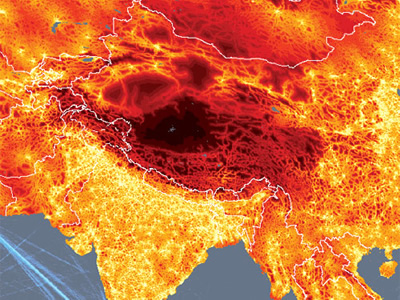 {Image via New Scientist}
{Image via New Scientist}
Plotted onto a map, the results throw up surprises. First, less than 10 per cent of the world's land is more than 48 hours of ground-based travel from the nearest city. What's more, many areas considered remote and inaccessible are not as far from civilisation as you might think. In the Amazon, for example, extensive river networks and an increasing number of roads mean that only 20 per cent of the land is more than two days from a city - around the same proportion as Canada's Quebec province.
The maps were created to show how the distribution of people affects their access to resources such as education and medical care, and how we are increasingly pushing wildlife out of even the wildest corners of our planet.
The first image shows the final map of connectedness while the second image shows a zoomed view over the world's most remote place: the Tibetan plateau. From here, says Andy Nelson, a former researcher at the European Commission, it is a three-week trip to the cities of Lhasa or Korla - one day by car and the remaining 20 on foot. Rough terrain and an altitude of 5200 metres make this the most secluded place on earth.
Rage of Nature Trailer from Bianca Casimes on Vimeo. The film the Rage of Nature follows director Josh Fox on his odyssey out West, as he encounters natural gas drilling activists, advocates & victims. Then we return with him back East, as he tries to stop the oncoming tide of natural gas drilling from slamming Pennsylvania and New York. We can’t let natural gas interests hijack our transition to clean energy, while drilling continues to go unchecked.
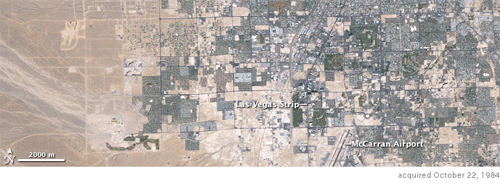 {25 years in six seconds via Archidose}
{25 years in six seconds via Archidose}
It's images like these, NASA satellite photos of 25 years of the growth of Las Vegas, that depict our existence as infectious growth on the land. Maybe I'm just feeling particularly cynical today, but is there any other way to describe it.
Our incessant need for "things" (full disclosure, I'm re-reading Thoreau's Walden) drives our ambitions at a unfounded pace. It began in the U.S. with Manifest Destiny, our seemingly inherent nomadic tendencies to wander, to find new lands, which is fine until our technology became so that we left scars on the land wherever we traveled.
It is a truly scary self-reflection to actually sit down and ask, "Why the fuck do we do it all?" Why do we build tall buildings? Why do we build giant corporations, hoard giant monies, build giant houses? It's scary, because if you answer it correctly, much of what we've frantically pursued in our lives (including my own), just doesn't mean much.
Sure, we're a product of everyone before us, it would be naive of me to think, at this point, at least in most areas in America, there is opportunity to live as comfortably as Thoreau does at Walden Pond, the space and resources just aren't there. But this paradigm shift we're reaching in sustainable living, and this global financial meltdown makes me think it's possible, and makes sense to return to a similar type of living. Not living beyond what we actually need as humans, food and shelter. Everything else might be considered frivolous pursuits.
 {Simon Dale's hand-built home for $5,000}
{Simon Dale's hand-built home for $5,000}
A young couple in Whales is doing just that. Managing on an annual income of just $10,000 went ahead and built their own cheap home anyway, sustainably, mostly out of materials from “a rubbish pile somewhere.”
They had wanted to spend as much time as possible at home while their two children were young. Their nearby woodlands ecological management work would have been impractical if they were paying a mortgage. So with the help of some friends and people simply passing by completed their very low impact homemade house. A hand built unique setting for a charmed life for their two young toddlers. Completed in just four months. Total expenditure? $5,000. Tools? A chisel, a chainsaw and a hammer. Building expertise? Home owner Simon Dale says:
“My experience is only having a go at one similar house 2yrs before and a bit of mucking around in-between. This kind of building is accessible to anyone. My main relevant skills were being able bodied, having self belief and perseverance and a mate or two to give a lift now and again.”
Sustainable design and construction:
The Dale's are now working on a precedent setting settlement of nine low-impact smallholdings where families can live and work on the land for a simple livelihood.
So its clearly possible, and I'd like to think we have the capability to live without greed, but I think it would take a massive event to globally change our living mentalities at this point.

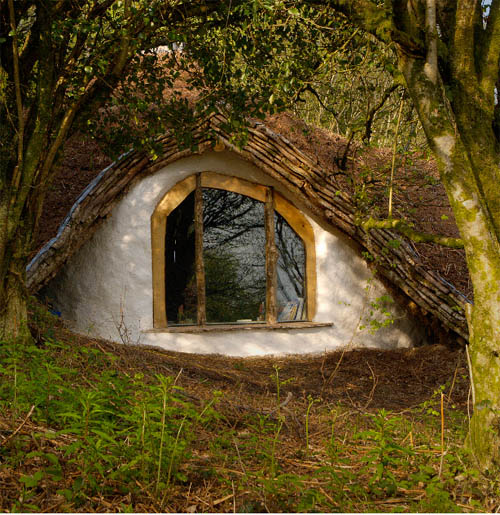
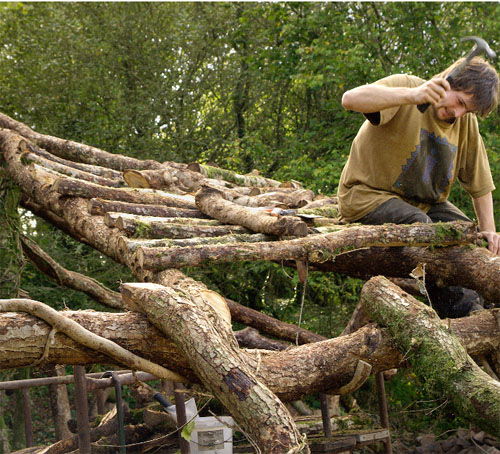 {Simon Dale's hand-built home for $5,000}
{Simon Dale's hand-built home for $5,000}